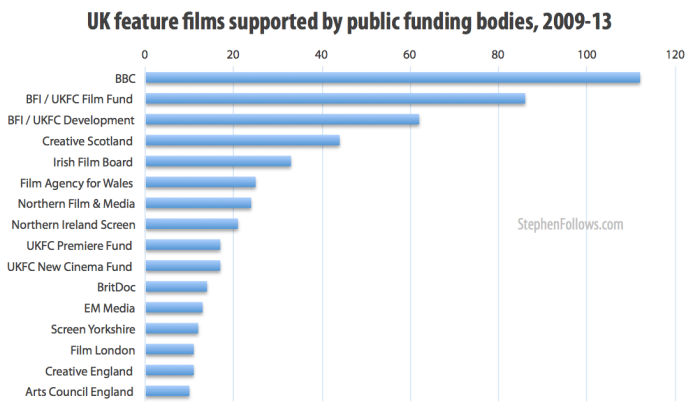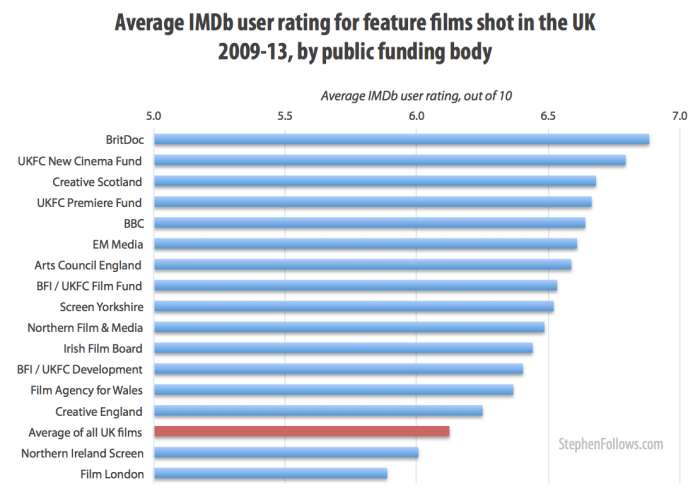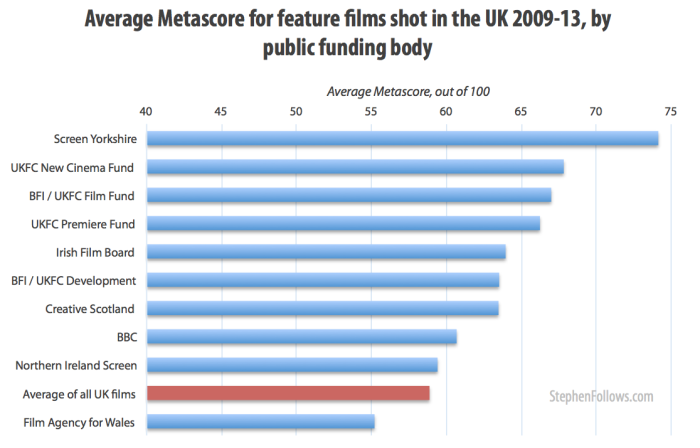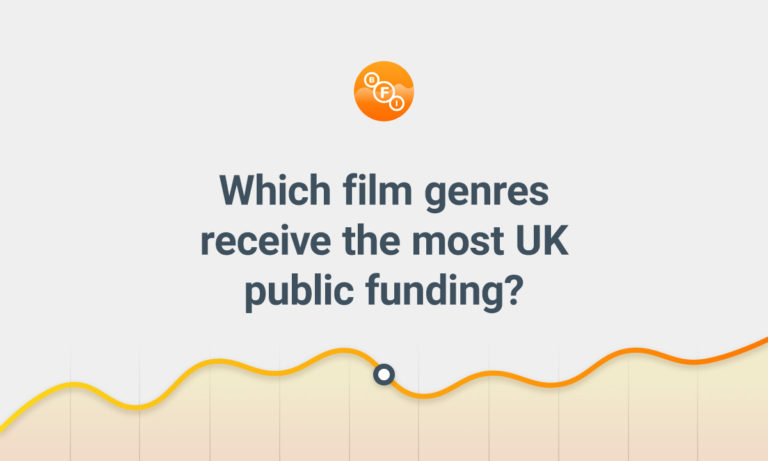 I recently had a conversation with someone who works at a major film public funding body (who shall remain nameless) and they said “I am starting to doubt if the films we fund are actually any better than the ones we don’t”.
I recently had a conversation with someone who works at a major film public funding body (who shall remain nameless) and they said “I am starting to doubt if the films we fund are actually any better than the ones we don’t”.
It sounded like a good topic to investigate so I agreed to do some research. This goes to the heart of why public funding for films exists – is it to train filmmakers, to foster creativity/art, to invest in an industry or for something else entirely? Without knowing why we support films with public funding we can’t agree on an objective set of factors to measure success.
However, in order to investigate this topic today I am going to take a leap and define “better” as “better received by audiences and critics”. In the past, I have studied how film critics and audiences rate films, who is distributing the best films in the UK, which types of adaptations make the best films and if British films are better than Hollywood films. In those examples I have used the Metascore and IMDb user ratings as a shorthand for determining what film critics and film audiences think of a film, so I’m going to do that again here. In summary…
- 20% of UK films shot 2009-13 received some form of public funding
- In 2012/13 HMRC paid out £206 million to British feature films
- 68.4% of film public funding goes towards production
- Between 2009-13 inclusive, 340 films received some form of UK-based public funding – those represent 20.1% of all films shot in the UK during that period.
- If a film was supported by one UK-based public body then there was a 57% chance that it was funded by a second public body.
- Film critics gave films with public funding an average of 63 out of 100, whereas the average for all UK films is 59.
- IMDb users rated films with public funding 6.5 out of 10, and the UK average is 6.1
Who are the public bodies funding films?
![]() The single largest UK public funder is the taxman; in the tax year 2012/13 HMRC paid out £206 million to British feature films. The scheme provides around 20% of the production budget back to the filmmakers in cash/tax refunds upon completion. It’s only open to films officially classed as “British”, although in practice the rules are so broad that almost all feature films shot in the UK are eligible. For today’s research I’m not going to include the Tax Credit as although it is technically public funding, it’s open to all films without a measure of quality.
The single largest UK public funder is the taxman; in the tax year 2012/13 HMRC paid out £206 million to British feature films. The scheme provides around 20% of the production budget back to the filmmakers in cash/tax refunds upon completion. It’s only open to films officially classed as “British”, although in practice the rules are so broad that almost all feature films shot in the UK are eligible. For today’s research I’m not going to include the Tax Credit as although it is technically public funding, it’s open to all films without a measure of quality.
Public funding for film in the UK by source, 2012/13
| Source | Amount | % of total |
|---|---|---|
| UK film production tax relief (HMRC) | £206,000,000 | 56.7% |
| National Lottery Distribution Fund | £65,400,000 | 18.0% |
| DCMS grant-in-aid to the BFI and NFTS | £27,900,000 | 7.7% |
| Film4/Channel 4 | £18,100,000 | 5.0% |
| BBC Films/BBC | £12,700,000 | 3.5% |
| National and Regional Development Agencies | £9,400,000 | 2.6% |
| EU MEDIA Programme | £5,600,000 | 1.5% |
| Arts Council England (ACE) | £4,300,000 | 1.2% |
| Welsh Assembly Government | £2,200,000 | 0.6% |
| Northern Ireland Executive | £2,100,000 | 0.6% |
| Scottish Government | £2,100,000 | 0.6% |
| Higher Education Funding Councils (HEFC) | £1,600,000 | 0.4% |
| Other EU | £1,100,000 | 0.3% |
| Foreign and Commonwealth Office | £1,100,000 | 0.3% |
| The Office of Communications (Ofcom) | £1,100,000 | 0.3% |
| Department for Business, Innovation & Skills | £800,000 | 0.2% |
| Skills Investment Fund training levy | £800,000 | 0.2% |
| Local government | £300,000 | 0.1% |
| UK Trade & Investment | £200,000 | 0.1% |
| Total | £363,400,000 |
The public funding I’m looking at today is discretionary awards made by public bodies toward development and production costs. Most (but not all) of this money is raised via the National Lottery and managed by the BFI. In 2013, public money spent on films with public funding was split as follows…
- 68.4% – Production
- 8.2% – Education, young people and lifelong learning
- 7.1% – Distribution and exhibition
- 5.0% – Film archives and heritage
- 3.6% – Administration and services to the public
- 3.4% – Training and skills
- 2.8% – Development
- 1.0% – Export and inward investment promotion
- 0.4% – Business support
How many films get awarded public funding?
 I used my database of films shot in the UK (based on BFI data) to build up a dataset of the 1,689 feature films shot in the UK in the five years between 2009 and 2013 inclusive. Although I was only studying a five year period, I found that the funding landscape changed significantly during that time.
I used my database of films shot in the UK (based on BFI data) to build up a dataset of the 1,689 feature films shot in the UK in the five years between 2009 and 2013 inclusive. Although I was only studying a five year period, I found that the funding landscape changed significantly during that time.
Most notably, the UK Film Council was closed in 2010, with its Lottery funding duties being passed to the BFI. In addition, the regional funding bodies changed from a collection of eleven regional screen agencies (nine in england plus one each for Wales and Scotland) to our current crop of five national screen agencies.
To further confuse matters, some of the old public regional screen agencies are still running but as private enterprises. And finally we have the rather shameful case of Screen East, which was shut down in 2010 after their finance manager was arrested for fraud! I am not here to speculate what all this change has meant for filmmakers, nor if it was successful, but it certainly makes the whole picture more complicated to track. For ease, I grouped together a few organisations who I felt covered the same remit. For full details of which organisations are included in each group please refer to the Notes section at the bottom of this article.
Overall, 340 films received some form of UK-based public funding – 20.1% of all films shot in the UK. In total, I found 141 films directly supported by the BFI or the UK Film Council (UKFC) which represents 8.3% of the films made in that period, or one in every twelve films. The BBC were involved with 112 films, or 6.6% of films made.  Other than the Irish Film Board, I did not track non-UK based public funding. Across public funding bodies in all countries, 417 of films shot in the UK received some sort of public funding support, UK or international.
Other than the Irish Film Board, I did not track non-UK based public funding. Across public funding bodies in all countries, 417 of films shot in the UK received some sort of public funding support, UK or international.
Like buses…
If a film was supported by one UK-based public body then there was a 57% chance that is was funded by a second public body. In summary, for all films shot in the UK between 2009-13…
- 79.9% of films were not supported by any UK-based public funding
- 11.4% of films were funded by just one UK-based public funding body
- 6.0% of films were supported by two UK-based public funding bodies
- 2.3% of films were supported by three UK-based public funding bodies
- 0.4% of films were supported by four or more UK-based public funding bodies
So, are the films with public funding better?
In a word, yes. I looked at the average Metascore and IMDb user ratings for all film shot in the UK and then compared that to the averages for films funded by UK-based public funding bodies. The UK average for British films during this period was 6.1 out of 10, whereas films backed by BritDoc achieved an average of 6.9 out of 10. Across all public-supported films, the average was 6.5 out of 10.  The Metascore is an average of film critics’ scores, and the average for films with public funding (63 out of 100) was higher than the overall average across all UK films (59 out of 100). My chart below includes fewer organisations as I only included bodies who had backed a minimum of five films with a Metascore.
The Metascore is an average of film critics’ scores, and the average for films with public funding (63 out of 100) was higher than the overall average across all UK films (59 out of 100). My chart below includes fewer organisations as I only included bodies who had backed a minimum of five films with a Metascore. 
What does this mean?
This is a tough question. What this is measuring is correlation, not causation. We can say that there is a connection between the quality of a film and the involvement of a public funding body but that doesn’t tell us why. It strikes me that the two most likely options are either that…
- Public funding bodies are good at spotting which scripts/ creatives are better; or
- The advice and notes public funders give filmmakers improve the final films
I don’t have enough information to be able to say with confidence which is the stronger of the two causes.
Notes
As stated above, there are a myriad of regional and national funding bodies involved in the films with public funding. I measured today. For ease, I grouped together bodies who I felt covered the same remit or region. This is a bit tricky to do from afar so if anyone reading this was involved with any of the now-defunct bodies and disagrees with how I grouped them then please drop me a line. I’m happy to explain more on a case-by-case basis and also to update this article to reverse any particularly egregious groupings.
- BBC includes BBC, BBC Films, BBC Scotland, BBC Northern Ireland, BBC Alba and BBC Worldwide.
- BFI / UKFC Film Fund includes BFI Film Fund and the UK Film Council Film Fund schemes, covering production and completion funding.
- Creative Scotland includes Creative Scotland, Scottish Screen, Scotland South West Screen Commission and Scottish Development Fund.
- Film Agency for Wales includes Film Agency for Wales, Wales Creative IP Fund and the Welsh Assembly.
- Northern Film & Media includes Northern Film & Media and NW Vision.
- Northern Ireland Screen includes Northern Ireland Screen, Northern Ireland Film & Television Commission and Northern Ireland Lottery Fund.
There are a number of notes that should be read when considering this research…
- Some films with public funding have benefited from post-completion funding, such as via the BFI’s Distribution Fund but they were harder to track and without a complete dataset I didn’t want to include them in the numbers.
- The years referenced in this article refer to when the film was shot, not when the award was made nor when the film was finally released.
- I included BritDoc as a public funder, due to the involvement of Channel 4 and the philanthropic nature of their funding which originates from the Bertha Foundation.
- Not all these films have been reviewed by critics tracked by Metascore and not all have enough ratings for IMDb to publish a user rating. Across all films I found that 77.3% of the films had a user rating and 21.5% had a Metascore.
The breakdown of how public money was spent in film came directly from the BFI. My database of films is based on raw material supplied by the BFI. I have then built upon that and cross-referenced it from public data from IMDb and Metascore. If you’re interested in finding out more then I would suggest reading the Arts Index of England from the National Campaign for the Arts.
Epilogue
I’ve not received any public funding for films I’ve made, although I am a big supporter of some of the work the BFI does. It’s a hot topic in the UK (especially as we’re going through a time of budget cuts across the board) and everyone seems to have a view. One pattern I’ve anecdotally spotted is that the likelihood of someone being supportive of public funding in film is directly linked to the level of funding they have personally received.





Comments
This is fascinating detail. Thank you so much. Could you explain how the tax relief works as I had no idea that this was the biggest public funder of UK films. Also, in order to determine the ‘Britishness’ of a film, do they use the cultural test that the UK Film Council introduced?
Glad you’re enjoying it.
Certainly. The tax relief is for all British films which are “intended for theatrical relief”. Let’s split this up into Britishness and intention for theatrical release.
Britishness
In order for a film to be officially classed as “British” it needs to pass the Cultural Test (bfi.org.uk/film-industry/british-certification-tax-relief/cultural-test-film). The test awards points based on the content of the film and of the cast, crew and facilities used in the production.
It’s quite a easy test for most films to pass. To be classed as British, your film needs at least 18 points from this list;
Note: Out of the possible six points 6th, 7th and 8th points in that list, you can claim a maximum of 4 points.
Theatrical release
“Intended for theatrical release” means screened in cinemas to the paying public. Interestingly, they don’t actually have to get to cinemas, but just be intended to. This is because the majoirty of lower budget films never make it to cinemas and yet are still valid feature films. This is the mechanism for the tax office to prevent websites, adverts, TV shows*, etc from claiming. *(Recently the have introduced a copy of the film tax credit for TV shows, which is a major reason why the new series of 24 was shot in the UK). It’s technically possible for short films to pass this test, and I know of a umber of filmmakers who have achieved this. I wrote about it a few years ago, although I can’t say if this method still works or not as the rules might have been chnaged since stephenfollows.com/uk-tax-credit-for-short-films.
Process
So once a film is complete (but often before it’s released) the produces will complete the cultural test, get certified as British and then apply for the tax credit within their company’s corporation tax return.
Hope this helps.
There is a lot of information including case studies on the HMRC website. You will need an accountant to do this, give Richard at FMTV accounting a try.
Thanks, Stephen, for another fascinating study. When you speculate on the connection between the quality of a film and the involvement of a public funding body, I wonder if public funding provides more funding towards the film’s budget than would be raised privately, which would suggest the more money the filmmakers have, the better quality the film might have in terms of production values and better paid cast and crew. Could you do a correlation between the publicly funded films and their total film budget (production + post), with the privately funded films and their budgets? This might provide another clue about the cause of quality or conversely, might suggest budget is not related to quality, which would then create stronger support for your hypothesis of better script quality for publicly funded films.
Interesting idea, Peter. Unfortunately I don’t have full, accurate data for film budgets so I can’t do the kind of work need to properly measure the collocation independent of budget factors. But that’s not to say we can’t test a few of those ideas.
I do have very broad budget categories from the BFI. Films backed by UK-based public funders are don’t tend to be in the “micro budget” range (i.e. under £150k) but they’re also not in the highest bracket (i.e. over £30m). The numbers for 2009-13 are…
I have just cross-refereed that data with the research of my main article and this is what I found for the IMDb user ratings
(I didn’t do the Metascore as there aren’t enough for each categories to be meaningful).
In my opinion, I think that the budget ranges I have are too vague to be able to draw useful conclusions from these results.
Really interesting article! Glad you caveated your conclusions at the end by saying its correlation and not causation on the film scores. My first instinct was that films without funding from a public body would tend to be those commercial cinema, bigger box office films? In that case you are more likely to get people who go on IMDB and give a one star review for poor performance, which skew results downwards (no one likes to read a hyped up review for a big film and then leave disappointed?) Whereas more “indie” films are more likely to have more balanced expectations?